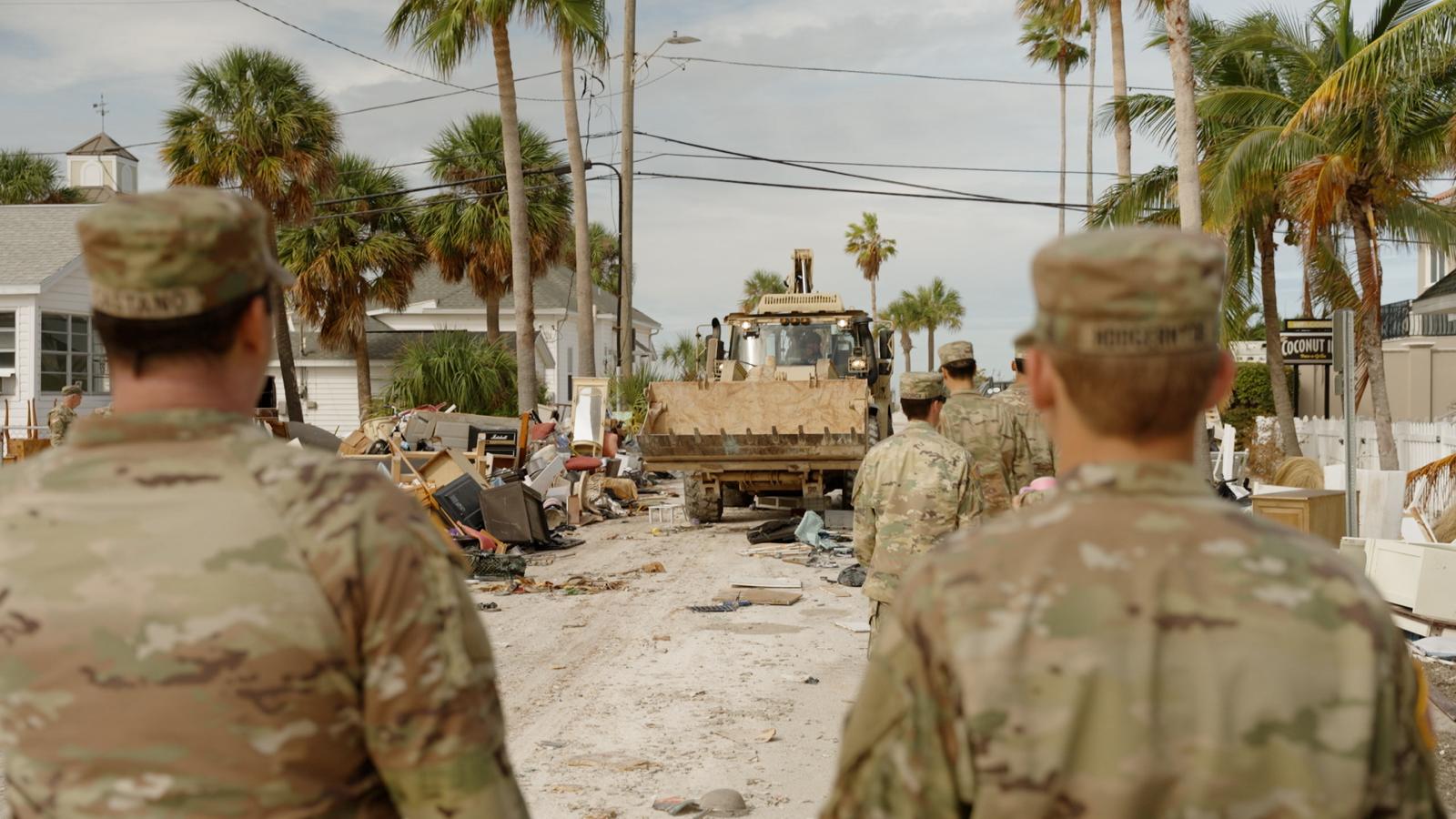

More than 5,000 National Guard troops have been mobilized ahead of Hurricane Milton which is expected to make landfall late Wednesday.
On Tuesday, the Florida National Guard activated nearly 5,000 of its members with 11 rotary-wing aircraft, more than 400 high-water vehicles and 16 watercraft as the state prepares for a storm that climate officials are warning could be “one of the most intense hurricanes on record” in the Atlantic basin which includes the North Atlantic Ocean, Caribbean Sea and the Gulf of Mexico.
Hurricane Milton is expected to impact the Tampa Bay area of Florida on Wednesday night as a high Category 3 or low Category 4 storm with officials preparing for high winds, storm surge, and severe flooding.
The National Weather Service, a federal agency that provides weather and climate forecasts, said the storm is expected to bring “destructive and life-threatening winds” and urged those living in evacuation zones to follow orders and leave their homes. “It’s a decision that could save your life,” the agency said.
In addition to the activation of Guard personnel, nearly 100 active duty troops have been mobilized to help with Hurricane Milton response and recovery at the request of the Federal Emergency Management Agency which is facing a shortfall of available workers, according to reporting from the New York Times. The active troops will assist FEMA’s search and rescue teams with non-technical logistics support, according to Army officials. The active duty response also includes a defense coordinating officer and a defense coordination element, 30 high-wheeled vehicles, helicopters for search and rescue operations, medium-lift helicopters for moving personnel and equipment, and command and control and sustainment for U.S. forces.
Subscribe to Task & Purpose today. Get the latest military news and culture in your inbox daily.
Julie Weckerlein, a spokesperson for the National Guard Bureau said in a statement to Task & Purpose that they’re monitoring Hurricane Milton’s speed, strength and track as it moves toward Florida’s Gulf Coast.
“We urge everyone in the path of the storm to stay tuned to local radio, television and weather radio for the latest on the storm and to heed the warnings of local and state emergency,” Weckerlein said.
On Monday, ahead of Milton’s expected impact, U.S. Army North moved personnel and equipment from a contingency command post to Fort Moore, Georgia, to be closer to the region to support FEMA and any requests for active-duty support from the governor of Florida. Army North serves as the land force component of the larger U.S. Northern Command and is the main organization charged with coordinating military support to help federal civilian agencies respond to natural or man-made disasters.
“U.S. Army North has unique capabilities, including the ability to deploy on short notice into austere environments, to support communities and the American public when needed,” said Maj. Gen. Scott M. Sherman, U.S. Army North and Joint Force Land Component Command commanding general. “Our priority is to be ready to assist and respond to help alleviate suffering in the impacted areas as quickly as possible.”
While a majority of assistance is coming from Army elements, the storm’s impact is being felt across the services.
Earlier this week, the Air Force moved aircraft and non-essential personnel out of MacDill Air Force Base ahead of a hurricane for the second time in a month. The first time they moved people and planes for Hurricane Helene, the damage included flooding, loss of power and fallen debris from a storm that passed through Florida but devastated states higher north.
This time around, Hurricane Milton is expected to hit directly where MacDill is located — inside Tampa Bay, on the western coast of Florida on the Gulf of Mexico.
In a video posted to Facebook on Oct. 6, Col. Edward Szczepanik, commander of the 6th Air Refueling Wing said he was ordering a “limited evacuation of Zone A for MacDill Air Force Base and Zones A and B and the mobile homes for the following counties: Hillsborough, Pinellas, Pasco, Hernando, Manatee, Sarasota and Citrus.”
The thousands of newly activated troops are joining more than 6,000 Army and Air National Guard troops from 19 states and 1,000 active duty troops from North Carolina who were already activated to support Hurricane Helene response efforts. Troops who responded to Helene originally helped with search and rescue during the storm and in the immediate aftermath.
Guard officials from North and South Carolina and Tennessee told reporters that the remaining troops have since moved to assist with recovery operations like clearing roadways, distributing aid and emergency supplies with C-17 aircraft and helping with other logistics at checkpoints in local communities. Some of the Guard members who responded in North Carolina, for example, have even been victims of Hurricane Helene themselves.
If you are a service member who has been mobilized in response to Hurricane Milton or Hurricane Helene, we’d like to hear about the relief operations you’ve been involved in. If you’d like to tell your story, or that of your unit and those in this community, please reach out to patty.nieberg@taskandpurpose.com.
The latest on Task & Purpose
- 100 Marines showed up for an Iwo Jima veteran’s 100th Birthday
- Brother and sister meet in the sky during refueling mission
- Space Force blasts first guardian into space
- The evolution of the Marine Corps’ Eagle, Globe and Anchor
- Army tankers send off platoon leader by strapping him to the Abrams’ main gun
